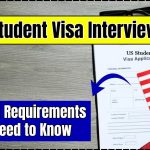US Visa Denied: Applying for a US visa can be a nerve-wracking experience. Many applicants face visa denials, leaving them frustrated and unsure about their next steps. But a denial is not the end of the road! You can reapply and improve your chances of approval by addressing the issues that led to your rejection.
This article will walk you through the common reasons for US visa denials, how to fix them, and the exact steps to reapply successfully. Whether you’re applying for a tourist visa (B1/B2), student visa (F1), work visa (H1B), or any other category, this guide will help you navigate the process with confidence.

US Visa Denied
| Topic | Details |
|---|---|
| Common Reasons for US Visa Denials | 214(b) (lack of strong ties), 221(g) (incomplete application), criminal records, misrepresentation |
| Reapplication Steps | Identify the reason for denial, strengthen your case, reapply with new evidence |
| Important Documents | Updated DS-160 form, proof of strong ties, financial documents, employer letter |
| Approval Rate | US visa approval rate is around 75%, but it varies by visa type and applicant country (source) |
| Official Resources | US Visa Information |
Getting denied for a US visa can be frustrating, but it’s not the end of your journey. By understanding the reasons for denial, strengthening your application, and presenting a stronger case during your interview, you can significantly improve your chances of approval.
Take your time, prepare well, and apply again with confidence!
Why Was Your US Visa Denied?
The first step to successfully reapplying for a US visa is to understand why you were denied in the first place. Visa denials are typically issued under specific sections of US immigration law. Below are the most common reasons:
1. Section 214(b) – Lack of Strong Ties to Home Country
- This is the most common reason for visa refusals.
- The consular officer was not convinced that you will return to your home country after your trip.
- Solution: Provide strong proof of your ties, such as employment, property ownership, family responsibilities, or business ownership.
- Example: If you are employed, show recent payslips, employment verification letters, or a letter from your employer stating your leave of absence and expected return date.
2. Section 221(g) – Incomplete Application or Additional Documents Needed
- Your application was put on hold because it lacked necessary documents or required further administrative processing.
- Solution: Submit the missing documents as soon as possible and follow any instructions given by the consulate.
- Example: If you applied for an H1B visa and were asked for additional proof of employment, provide a job contract, pay stubs, and tax returns.
3. Misrepresentation or Fraud (Section 212(a)(6)(C))
- Providing false information on your application can lead to permanent ineligibility.
- Solution: Always provide accurate details and, if a mistake was made, clarify it in your reapplication.
- Example: If you mistakenly provided the wrong employment dates, submit a letter explaining the error along with a corrected employment verification letter.
4. Criminal Record or Previous Immigration Violations
- If you have a criminal background or overstayed a previous visa, this can impact your application.
- Solution: Seek legal advice if necessary and present documents that explain your situation.
- Example: If you overstayed your previous visa due to medical reasons, provide hospital records, doctor’s letters, and any proof of extenuating circumstances.
How to Reapply for a US Visa After a Denial
Once you understand the reason for your visa denial, it’s time to correct the issue and reapply. Follow these step-by-step instructions:
Step 1: Gather Stronger Supporting Documents
If your visa was denied due to lack of strong ties, provide more compelling evidence:
- Employment: Offer an employment verification letter with salary details.
- Property Ownership: Show deeds, rental agreements, or mortgage documents.
- Family Ties: Submit birth or marriage certificates proving family responsibilities.
- Financial Stability: Provide bank statements, tax returns, and proof of ongoing income.
Step 2: Complete a New DS-160 Form
- Every visa applicant must fill out a new DS-160 form (Apply Here).
- Ensure that all details are accurate and consistent with your supporting documents.
- Print the confirmation page for your interview.
Step 3: Pay the Visa Fee Again
- Unfortunately, visa fees are non-refundable. You will need to pay the application fee again when reapplying.
- Check the latest fee details on the US Department of State Website.
Step 4: Schedule a New Interview
- Book a visa appointment at the same US embassy or consulate where you were denied.
- If your circumstances have significantly changed, you may try another consulate.
Step 5: Prepare for the Interview
The visa interview is crucial! Follow these best practices:
- Be Honest: Answer questions truthfully and confidently.
- Stay Consistent: Ensure your answers match your DS-160 form.
- Be Clear About Your Travel Plans: Explain why you are visiting the US and how it benefits you.
- Show Stronger Ties: If denied under 214(b), emphasize what has changed since your last application.
- Practice with a Mock Interview: Simulate common visa interview questions with a friend or an immigration consultant.
Step 6: Attend the Visa Interview
- Arrive on time with all necessary documents.
- Dress professionally and be polite and respectful.
- If asked about your previous denial, explain what new information you are providing.
Top Visa-on-Arrival Locations for US Travelers in 2025: Check Details!
US Visa Types Explained: Immigrant vs. Non-Immigrant in 2025—What You Need to Know!
New Zealand’s Active Investor Plus Visa Changes for 2025 – What It Means for You!
FAQs About US Visa Denied
1. How soon can I reapply after a visa denial?
There is no mandatory waiting period to reapply. However, unless you have significant new evidence, it’s best to wait at least 3-6 months before reapplying.
2. Can I appeal a US visa denial?
Most US visa denials cannot be appealed. The best option is to reapply with better documentation.
3. Does a previous visa denial affect future applications?
A past denial does not automatically disqualify you. However, it stays on record, so you must correct past mistakes before reapplying.
4. What percentage of visa reapplications get approved?
Visa approval rates vary, but the global average is around 75%. If you address the reason for your denial effectively, your chances improve significantly.
5. Should I hire an immigration lawyer?
For complex cases, such as previous overstays or criminal records, consulting a lawyer can increase your odds of success.











